

Swallow7sow.wikispaces.com/file/view/Two-Year+KS3+Scheme+of+Work_Yr+1FUSION.pdf. What is Matter? Water is everywhere-even in the air!

People describe objects in many ways using size, shape, colors, and textures. Describing objects by using size (place images here) shape color texture uses an object's properties. A property describes how an object looks, feels, or acts. Name one property of the birthday present? Properties of all objects Objects take up space. All objects take up space. Objects have mass. Mass is how much there is of an object. Objects that take up space and have mass are called matter. If you are having trouble understanding matter, look all around you. Let's take this carrot: Let's get closer and closer to the smaller parts of the carrot-carrot atoms!
These small parts of the carrot are called atoms. All matter is the same because all matter is made up of atoms. Properties of Matter Remember all objects take up space and have mass. Density is an important physical property. Properties are constantly changing... Matter is constantly changing. The Nine Dot Challenge! Why does it happen?
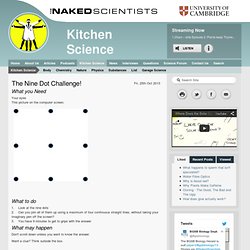
Which part of the brain is responsible? The right side of the prefrontal cortex (the bit of your brain just behind your forehead) Why is this happening? Our minds have evolved to solve certain problems effortlessly, yet we struggle to solve others that require us to 'think outside the box'. This 9 dot puzzle is an example of thinking creatively. Why do scientists study this? Scientists want to know whether you stimulate people to think outside the box and solve puzzles like this by tweaking with the activity of the brain. 11 Awesome Science Experiments Your Kids Will Love To Try. Life Parenting NEXT 11 Awesome Science Experiments Your Kids Will Love To Try by erin.c from Different Solutions Share on Facebook Share on Twitter Page 1 of 3 As a kid, science was never my favorite subject. 1.
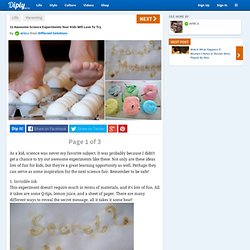
This experiment doesn't require much in terms of materials, and it's lots of fun. Via showtellshare. Ordinary Life Magic: Leaf Chromatography. The object is to draw the colors of the chlorophyll from the leaves, and to have the colors separate via chromatography.
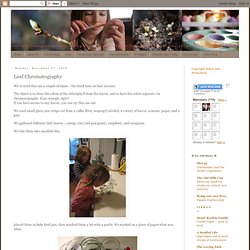
Easy enough, right? If you have access to any leaves, you can try this one out. We used small glass jars, strips cut from a coffee filter, isopropyl alcohol, a variety of leaves, scissors, paper, and a pan. We gathered different (fall) leaves – catnip, rose (red and green), raspberry, and evergreen. We tore them into smallish bits, placed them in baby food jars, then mashed them a bit with a pestle. The first time (a couple of years ago) we tried this experiment, we used spinach, and couldn’t get any colors onto our chromatogram (filter paper).The second time (a few weeks ago), we found it very difficult to keep the water hot, and didn’t have satisfactory markings, either.So the third time, we placed our jars in a pan of shallow water, and heated the jars on the lowest temperature for several minutes.
Growing Marshmallows in the Microwave. I should provide a word of caution on this.
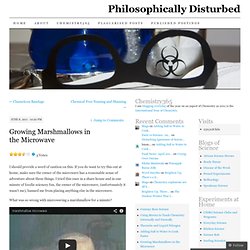
If you do want to try this out at home, make sure the owner of the microwave has a reasonable sense of adventure about these things. I tried this once in a share house and in one minute of foodie sciencey fun, the owner of the microwave, (unfortunately it wasn’t me), banned me from placing anything else in the microwave. What was so wrong with microwaving a marshmallow for a minute?
Okay, so it could have been the fact that the marshmallow got bigger in the microwave as it heated up. This is nothing to be worried about. The gas molecules in the air bubbles begin to move faster and push harder against the marshmallow walls, and because they are now softer, they now allow the air bubbles to expand. Once you take the marshmallow out of the microwave the marshmallow collapses as the air bubbles shrink when exposed to the much cooler room temperatures and sugar hardens.
- states of matter. The Atom and the Periodic Table. Downloads.bbc.co.uk/schools/teachers/bang/bang_teacherspack.pdf. Sound Through a Medium: Wobbling Bubbles. The Minty Cola Fountain. Turn Milk into Plastic - CanTEEN. Your Challenge: Turn Milk into Plastic What You Need: MilkVinegarMicrowavable containerMugPaper TowelsSpoon Here’s How: Heat one cup of milk in the microwavable container.
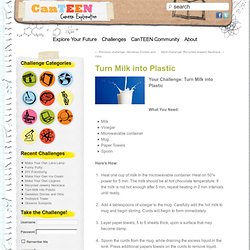
Heat on 50% power for 5 min. Take it Further: Add glitter or food coloring to the wet curds to create different colored shapes. How It Works: Plastics are all similar, containing molecules that are repeated over and over again into a chain called polymers. Fun Facts: Oil and water. Organ Systems in the Human Body Printable (3rd - 7th Grade. KS3 Science-Chemistry Quiz on "Acids, alkalis, simple reactions, particle theory gas-liquid-solid models and solutions" (based on QCA 7E, 7F, 7G and 7H)